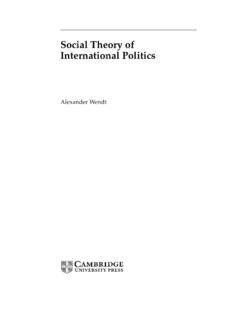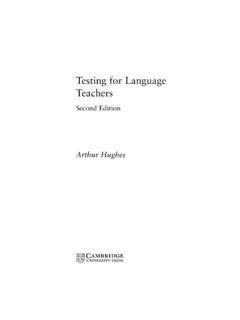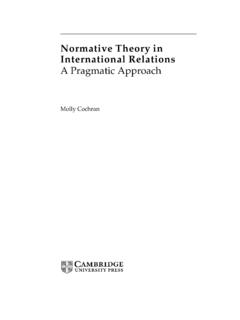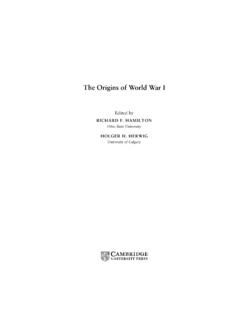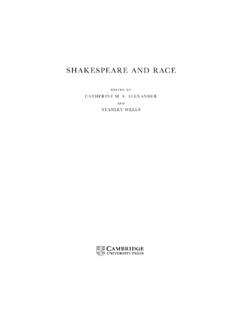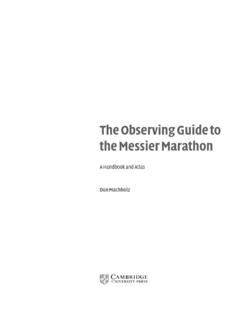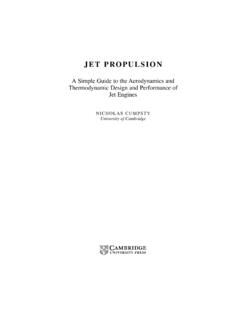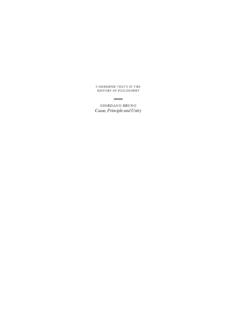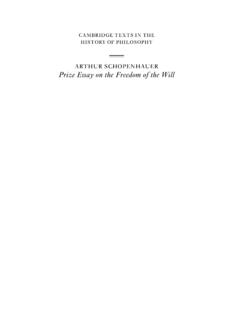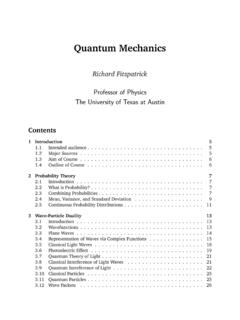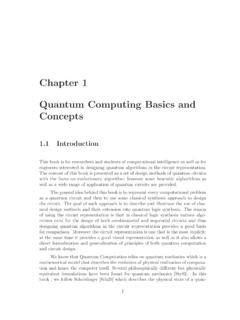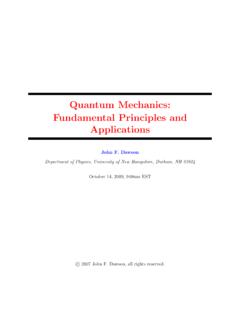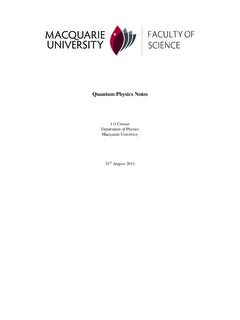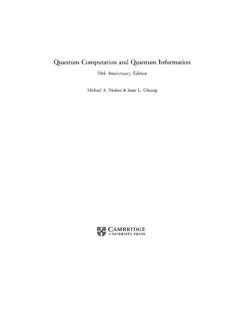Transcription of PRINCIPLES OF QUANTUM MECHANICS
1 PRINCIPLES OFQUANTUM MECHANICSas Applied to Chemistry and Chemical PhysicsDONALD D. FITTSU niversity of Pennsylvaniapublishedbythepresssyndicate oftheuniversityofcambridgeThe Pitt Building, Trumpington Street, Cambridge, United Kingdomcambridge university pressThe Edinburgh Building, Cambridge CB2 2RU, UK West 20th Street, New York, NY 10011-4211, USA Stamford Road, Oakleigh, Melbourne 3166, Australia#D. D. Fitts 1999 This book is in copyright. Subject to statutory exceptionand to the provisions of relevant collective licensing agreements,no reproduction of any part may take place withoutthe written permission of Cambridge University published 1999 Printed in the United Kingdom at the University Press, CambridgeTypeset in Times 11=14pt, in 3B2 [KT]A catalogue record for this book is available from the British LibraryLibrary of Congress Cataloguing in Publication dataFitts, Donald D.
2 , 1932 PRINCIPLES of QUANTUM MECHANICS : as applied to chemistry andchemical physics / Donald D. bibliographical references and indexISBN 0 521 65124 7 (hc.). ISBN 0 521 65841 1 (pbk.)1. QUANTUM chemistry. I. dc2198-39486 CIPISBN 0 521 65124 7 hardbackISBN 0 521 65841 1 paperbackContentsPrefaceviiiChapter 1 The wave Wave Wave Dispersion of a wave Particles and Heisenberg uncertainty Young's double-slit Stern Gerlach Physical interpretation of the wave function29 Problems34 Chapter 2 Schro dinger wave The Schro dinger The wave Expectation values of dynamical Time-independent Schro dinger Particle in a one-dimensional Particles in three Particle in a three-dimensional box61 Problems64 Chapter 3 General PRINCIPLES of QUANTUM Linear Eigenfunctions and Hermitian Eigenfunction Simultaneous Hilbert space and Dirac Postulates of QUANTUM
3 Parity Hellmann Feynman Time dependence of the expectation Heisenberg uncertainty principle99 Problems104 Chapter 4 Harmonic Classical QUANTUM Matrix Heisenberg uncertainty Three-dimensional harmonic oscillator125 Problems128 Chapter 5 Angular Orbital angular Generalized angular Application to orbital angular The rigid Magnetic moment151 Problems155 Chapter 6 The hydrogen Two-particle The hydrogen-like The radial Atomic Spectra187 Problems192 Chapter Electron Spin angular Spin Spin orbit interaction201 Problems206viContentsChapter 8 Systems of identical Permutations of identical Bosons and Completeness Non-interacting The free-electron Bose Einstein condensation229 Problems230 Chapter 9 Approximation Variation Linear variation Non-degenerate perturbation Perturbed harmonic Degenerate perturbation Ground state of the helium atom256 Problems260 Chapter 10 Molecular Nuclear structure and Nuclear motion in diatomic molecules269 Problems279 Appendix A Mathematical formulas281 Appendix B Fourier series and Fourier integral285 Appendix C Dirac delta function292 Appendix D Hermite polynomials296 Appendix E Legendre and associated Legendre polynomials301 Appendix F Laguerre and associated Laguerre polynomials310 Appendix G Series solutions of differential equations318 Appendix H
4 Recurrence relation for hydrogen-atom expectation values329 Appendix IMatrices331 Appendix J Evaluation of the two-electron interaction integral341 Selected bibliography344 Index347 Physical constantsContentsvii1 The wave functionQuantum MECHANICS is a theory to explain and predict the behavior of particlessuch as electrons, protons, neutrons, atomic nuclei, atoms, and molecules, aswell as the photon the particle associated with electromagnetic radiation orlight. From QUANTUM theory we obtain the laws of chemistry as well asexplanations for the properties of materials, such as crystals, semiconductors,superconductors, and super uids. Applications of QUANTUM behavior give ustransistors, computer chips, lasers, and masers.
5 The relatively new eld ofmolecular biology, which leads to our better understanding of biologicalstructures and life processes, derives from QUANTUM considerations. Thus, QUANTUM behavior encompasses a large fraction of modern science and theory was developed during the rst half of the twentieth centurythrough the efforts of many scientists. In 1926, E. Schro dinger interjected wavemechanics into the array of ideas, equations, explanations, and theories thatwere prevalent at the time to explain the growing accumulation of observationsof QUANTUM phenomena. His theory introduced the wave function and thedifferential wave equation that it obeys. Schro dinger's wave MECHANICS is nowthe backbone of our current conceptional understanding and our mathematicalprocedures for the study of QUANTUM presentation of the basic PRINCIPLES of QUANTUM MECHANICS is containedin the rst three chapters.
6 Chapter 1 begins with a treatment of plane wavesand wave packets, which serves as background material for the subsequentdiscussion of the wave function for a free particle. Several experiments, whichlead to a physical interpretation of the wave function, are also described. InChapter 2, the Schro dinger differential wave equation is introduced and thewave function concept is extended to include particles in an external potential eld. The formal mathematical postulates of QUANTUM theory are presented inChapter Wave motionPlane waveA simple stationary harmonic wave can be represented by the equation (x) cos2 x and is illustrated by the solid curve in Figure The distance between peaks(or between troughs) is called thewavelengthof the harmonic wave.
7 The valueof (x) for any given value ofxis called theamplitudeof the wave at thatpoint. In this case the amplitude ranges from 1to 1. If the harmonic wave isAcos(2 x= ), whereAis a constant, then the amplitude ranges from Ato A. The values ofxwhere the wave crosses thex-axis, , where (x) equalszero, are thenodesof (x).If the wave moves without distortion in the positivex-direction by an amountx0, it becomes the dashed curve in Figure Since the value of (x)atanypointxon the new (dashed) curve corresponds to the value of (x) at pointx x0on the original (solid) curve, the equation for the new curve is (x) cos2 (x x0)If the harmonic wave moves in time at a constant velocityv, then we have therelationx0 vt, wheretis the elapsed time (in seconds), and (x) becomes (x,t) cos2 (x vt)Suppose that in one second, cycles of the harmonic wave pass a xed pointon thex-axis.
8 The quantity is called thefrequencyof the wave. The velocity (x)x0 /23 /2 2xFigure A stationary harmonic wave. The dashed curve shows the displacement ofthe harmonic wave wave functionvof the wave is then the product of cycles per second and , the length ofeach cyclev and (x,t) may be written as (x,t) cos 2 x t It is convenient to introduce thewave number k, de ned ask 2 (1:1)and theangular frequency , de ned as 2 (1:2)Thus, the velocityvbecomesv =kand the wave (x,t) takes the form (x,t) cos(kx t)The harmonic wave may also be described by the sine function (x,t) sin(kx t)The representation of (x,t) by the sine function is completely equivalent tothe cosine-function representation; the only difference is a shift by =4 in thevalue ofxwhent 0.
9 Moreover,anylinear combination of sine and cosinerepresentations is also an equivalent description of the simple harmonic most general representation of the harmonic wave is the complex function (x,t) cos(kx t) i sin(kx t) ei(kx t)(1:3)where i equals 1pand equation ( ) from Appendix A has been intro-duced. The real part, cos(kx t), and the imaginary part, sin(kx t), of thecomplex wave, ( ), may be readily obtained by the relationsRe [ei(kx t)] cos(kx t) 12[ (x,t) (x,t)]Im [ei(kx t)] sin(kx t) 12i[ (x,t) (x,t)]where (x,t) is the complex conjugate of (x,t) (x,t) cos(kx t) i sin(kx t) e i(kx t)The function (x,t) also represents a harmonic wave moving in the functions exp[i(kx t)] and exp[ i(kx t)] represent harmonicwaves moving in the negativex-direction.
10 The quantity (kx t) is equal tok(x vt)ork(x x0). After an elapsed timet, the value of the shiftedharmonic wave at any pointxcorresponds to the value at the pointx x0attimet 0. Thus, the harmonic wave has moved in the Wave motion3 The moving harmonic wave (x,t) in equation ( ) is also known as aplane wave. The quantity (kx t) is called thephase. The velocity =kisknown as thephase velocityand henceforth is designated byvph, so thatvph k(1:4)Composite waveA composite wave is obtained by the addition or superposition of any numberof plane waves (x,t) Xnj 1 Ajei(kjx jt)(1:5)whereAjare constants. Equation ( ) is a Fourier series representation of (x,t). Fourier series are discussed in Appendix B. The composite wave (x,t) is not a moving harmonic wave, but rather a superposition ofnplanewaves with different wavelengths and frequencies and with different ampli-tudesAj.
